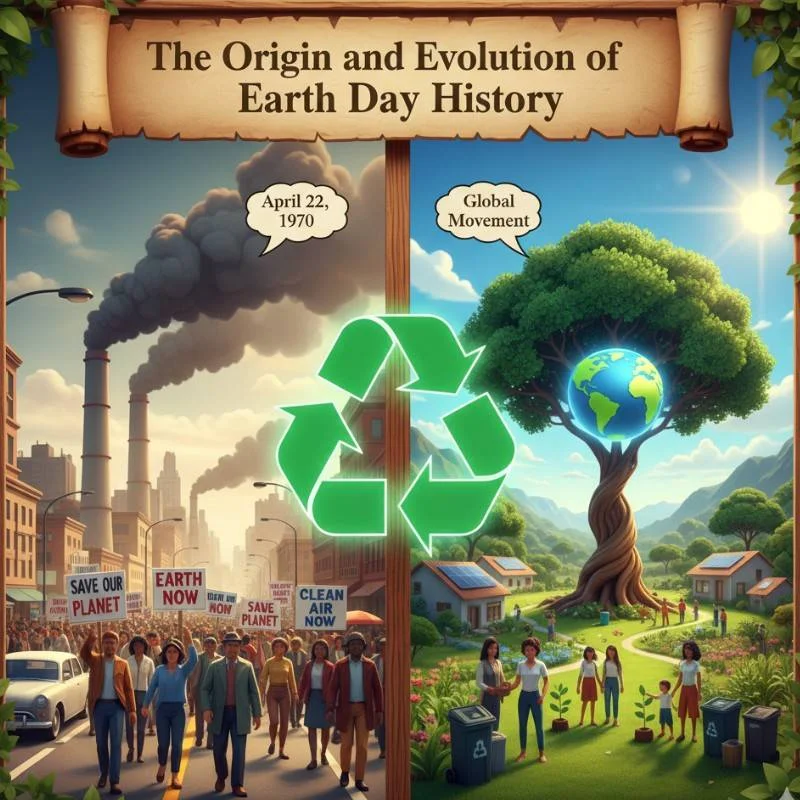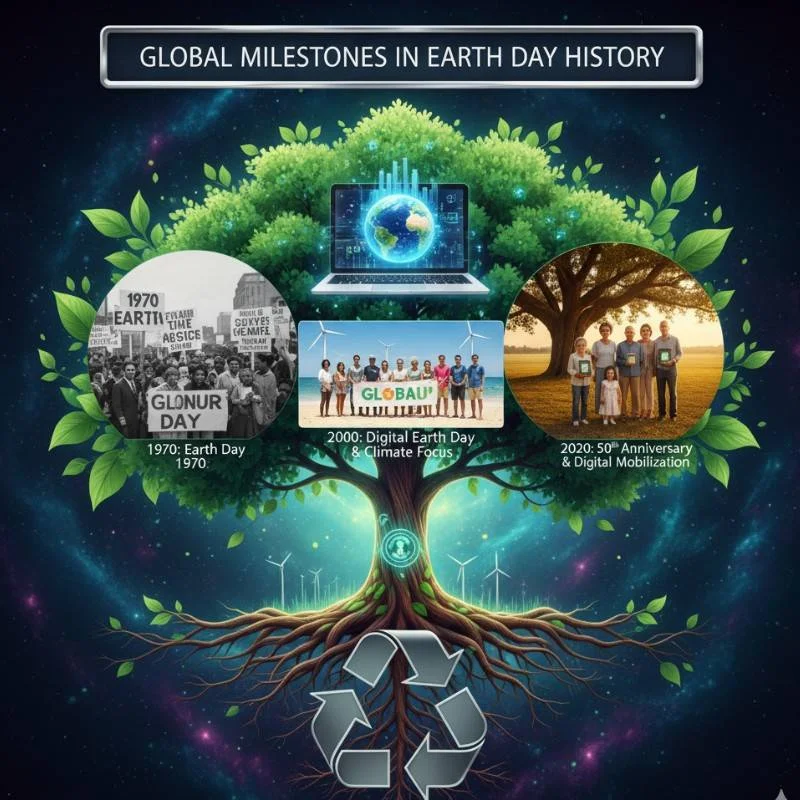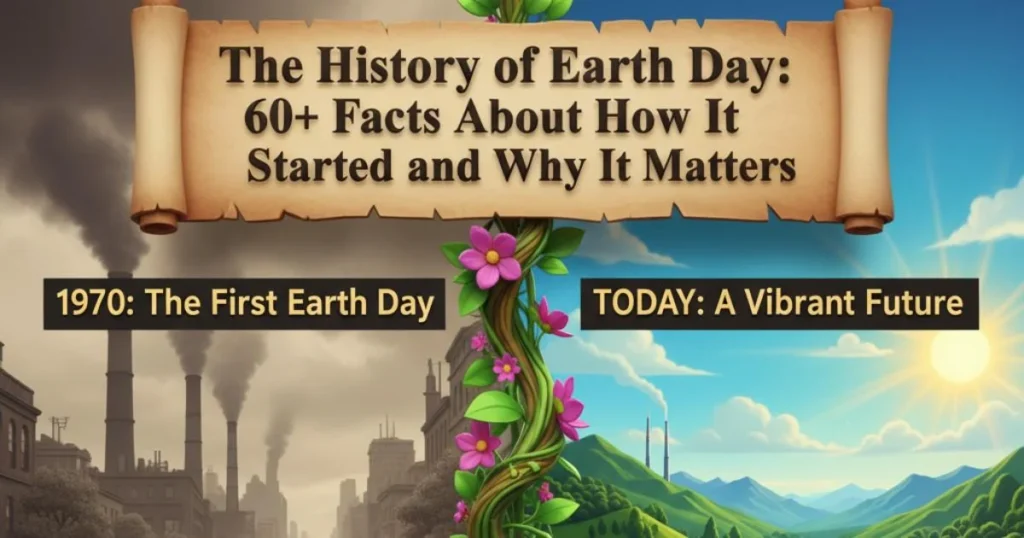Earth Day History is more than just a date on the calendar—it’s the story of how one movement transformed the way we care for our planet. When we look back at the Earth Day History, we uncover the roots of a global effort that began over 50 years ago, uniting millions in the name of environmental protection. Understanding Earth Day History helps us realize why every year, on April 22, people around the world plant trees, clean parks, and raise their voices for a greener future.
Ever wondered why this single day inspires so much global action? That’s all thanks to Earth Day—a movement that started small but grew into the world’s biggest environmental celebration. The story behind Earth Day History isn’t just about saving the environment; it’s about how one idea sparked unity across generations and continents.
In this article, we’ll dive deep into Earth Day History, uncover how it began, and explore why it still matters today. By the end, you’ll see how a single spark of awareness turned into a worldwide call for action—and why your role in protecting the Earth is more vital than ever.
Compelling Reasons Why Earth Day Is Essential for Our Planet
- Earth Day reminds us of our shared responsibility to protect the environment. It highlights the urgent need for action against climate change and pollution. If you love sharing thoughtful messages, explore our Heartfelt Eid Wishes or Creative Gift Box Ideas to spread positive care beyond Earth Day. By observing this day, people unite globally to restore balance in nature and promote a healthier planet.
- Celebrating Earth Day encourages sustainable habits in everyday life. From reducing waste to conserving water, it inspires individuals to make mindful choices. These small actions, when multiplied across communities, create a lasting positive impact on the Earth’s ecosystems.
- Earth Day plays a vital role in educating people about environmental challenges. Schools, organisations, and media campaigns spread awareness on topics like deforestation, ocean pollution, and renewable energy. This knowledge motivates people to take meaningful steps toward sustainability.
- The day strengthens global cooperation for environmental protection. Governments, NGOs, and citizens come together to address issues like carbon emissions and biodiversity loss. Such unity fosters collective responsibility and accelerates progress toward a greener world.
- Earth Day empowers young generations to take leadership in conservation efforts. It sparks passion among students to innovate, recycle, and advocate for eco-friendly change. Their creativity and enthusiasm drive hope for a more sustainable future.
- The observance also highlights the importance of preserving natural resources. It reminds us that clean air, fertile soil, and freshwater are limited treasures. Protecting these essentials ensures a thriving planet for future generations.
- Earth Day encourages innovation in green technology and energy efficiency. From solar panels to electric vehicles, it promotes cleaner alternatives to harmful industrial practices. These advancements help reduce humanity’s carbon footprint and restore ecological balance.
- Finally, Earth Day cultivates a deeper emotional connection between people and nature. Celebrate this spirit online with our 500+ Captions for Lovebirds That Capture True Lovebirds or Sweet Captions for Every Post that express love and appreciation for the world around you. It inspires appreciation for forests, oceans, and wildlife, nurturing a sense of belonging and gratitude. This renewed respect drives continuous commitment to protect the planet we call home.
Our Responsibility Towards the Earth and the Environment
- Caring for our planet begins with small, conscious actions that protect its natural balance. Every effort to reduce waste, conserve energy, and respect ecosystems helps sustain life. Our daily habits define the health of the Earth for generations to come.
- Preserving biodiversity is one of the greatest gifts we can give to the environment. Every plant, animal, and microorganism plays a role in maintaining ecological harmony. Protecting their habitats ensures the continuity of nature’s intricate web.
- Reducing pollution is not just a choice—it’s a necessity for survival. Clean air, pure water, and fertile soil are vital for human health and global balance. By minimizing toxins and emissions, we allow nature to heal and thrive.
- Using renewable energy sources like solar and wind can transform our world. These clean alternatives reduce dependency on fossil fuels and curb greenhouse gases. Embracing sustainable power leads to a brighter and healthier future.
- Planting trees is one of the simplest yet most powerful environmental actions. Trees absorb carbon dioxide, release oxygen, and provide shelter for countless species. Each seed planted strengthens the Earth’s resilience against climate change.
- Waste management reflects our respect for the planet. Recycling, reusing, and reducing consumption minimize the burden on landfills. A conscious effort to manage resources responsibly keeps our environment cleaner and safer.
- Educating future generations about environmental care is vital. Knowledge shapes attitudes and inspires sustainable choices from an early age. Awareness builds a foundation for responsible citizens who value and protect nature.
- Every individual has the power to make a difference. Simple acts like saving water, avoiding plastic, and supporting green initiatives create lasting impact. When we unite for the planet, we secure the well-being of all living things.
The Origin and Evolution of Earth Day History
- The idea of Earth Day began in the late 1960s when rising pollution and industrial waste sparked public concern. People started noticing the visible damage to rivers, air, and wildlife. This growing awareness led to a call for a national environmental movement.
- In 1970, U.S. Senator Gaylord Nelson initiated the first Earth Day to promote environmental education. His vision united millions of people across cities and campuses. This historic event marked the beginning of a global environmental consciousness.
- The success of the first Earth Day influenced new laws for clean air, water, and endangered species. Governments realized the urgent need for environmental protection. It became a turning point in how nations approached ecological preservation.
- During the 1980s, Earth Day transformed into a worldwide event celebrated in multiple countries. Environmentalists used this platform to highlight global challenges like deforestation and ozone depletion. The movement’s reach expanded beyond borders and cultures.
- By the 1990s, technology and media amplified Earth Day’s message to millions. Television campaigns, documentaries, and school programs inspired individual action. The focus shifted toward sustainability and community involvement.
- The new millennium saw Earth Day addressing climate change and renewable energy. Global summits and eco-friendly initiatives encouraged nations to adopt green policies. It became more than a day—it evolved into a year-round movement for change.
- In recent years, digital activism has reshaped how Earth Day is celebrated. Social media campaigns connect people, share awareness, and inspire eco-friendly habits. The power of online unity has strengthened environmental advocacy like never before.
- Today, Earth Day symbolises hope, resilience, and shared responsibility. It reminds humanity of its duty to protect the planet for future generations. The journey from a local movement to a global cause continues to inspire positive change worldwide.

Key Figures Behind Earth Day History
- Senator Gaylord Nelson, often called the father of Earth Day, envisioned a movement that would unite citizens in environmental protection. His passion for ecology inspired millions to take action. Through his leadership, the first Earth Day in 1970 became a turning point for global awareness.
- Denis Hayes, a young Harvard student, played a vital role in organising the inaugural Earth Day. His energy and strategic planning brought together schools, communities, and activists. Hayes later continued his environmental advocacy, expanding Earth Day into an international event.
- Rachel Carson’s groundbreaking book Silent Spring awakened the world to the dangers of pollution and pesticides. Her courage to challenge industrial giants transformed public understanding of ecology. Her work laid the foundation for modern environmental consciousness.
- John McConnell, a peace activist, originally proposed a day to celebrate the Earth’s beauty and life. His vision emphasised harmony between humanity and nature. The idea quickly gained traction and became part of a broader environmental initiative.
- Margaret Mead, the renowned anthropologist, championed Earth Day as a moral responsibility for humanity. She believed preserving the planet was essential for cultural survival. Her advocacy inspired scientists and educators to promote environmental ethics worldwide.
- Pete McCloskey, a congressman and environmental advocate, co-chaired the first Earth Day with Senator Nelson. His commitment to conservation shaped early environmental legislation. McKinley’s efforts demonstrated that bipartisan cooperation could drive ecological progress.
- Barry Commoner, a biologist and activist, linked scientific understanding with social responsibility. His research on pollution and energy use helped shape the environmental movement. Commoner’s belief that “everything is connected” remains a guiding principle of sustainability.
- David Brower, the first executive director of the Sierra Club, used his influence to promote preservation and awareness. His campaigns against overdevelopment inspired countless activists. Brower’s passion ensured that protecting nature became a public priority.
How Earth Day History Inspires Change Today
- The first Earth Day in 1970 marked a turning point in global awareness about environmental protection. It brought millions together to demand cleaner air, water, and land. Today, that same unity inspires modern movements focused on climate justice and sustainability.
- From its beginnings as a grassroots protest, Earth Day evolved into a worldwide celebration of environmental consciousness. Its legacy reminds us that small collective actions can spark major policy reforms. This enduring spirit motivates new generations to fight for a greener planet.
- Earth Day’s foundation was built on education and activism, teaching people to value nature as more than a resource. This principle continues to guide eco-friendly campaigns worldwide. The emphasis on awareness has transformed lifestyles and inspired ethical consumer choices.
- The power of Earth Day lies in its ability to turn concern into action. What began as a call for pollution control now drives global climate strategies. Its history fuels today’s innovation in renewable energy, green architecture, and sustainable technologies.
- By reflecting on Earth Day’s past, we understand the importance of persistence in advocacy. Environmental change takes time, yet the early efforts remind us never to give up. This patience and resilience continue to shape modern conservation efforts.
- Earth Day demonstrated that unity across cultures could create real progress. The global participation it inspired still echoes in today’s environmental summits. The historical cooperation between nations laid the foundation for shared climate goals.
- The origins of Earth Day highlight how public voices can influence powerful institutions. It showed that awareness can push governments and corporations toward responsibility. Today’s activists build on that momentum to demand accountability for ecological damage.
- Each Earth Day rekindles the vision of a planet where humans live in harmony with nature. Its history teaches us that awareness must lead to consistent action. That timeless message continues to inspire meaningful change across generations.

Global Impact of Earth Day Throughout History
- Since its first celebration in 1970, Earth Day has become a global movement uniting millions across nations to protect the planet. It marked a turning point in environmental awareness, inspiring countries to recognize the urgency of ecological balance. The movement proved that collective action can lead to meaningful global change.
- Over the decades, Earth Day has influenced international environmental policies and agreements. From clean air acts to renewable energy commitments, it has shaped how governments address climate challenges. Its impact continues to drive political and social responsibility toward sustainability.
- The event has inspired countless organisations to adopt eco-conscious practices. Businesses began integrating green initiatives, reducing waste, and supporting environmental projects. This shift redefined corporate responsibility as a vital component of global progress.
- Educational institutions around the world embraced Earth Day to teach future generations about the environment. Schools introduced sustainability programs and eco-clubs, nurturing a culture of awareness and action. This educational impact continues to empower young minds to protect the Earth.
- Earth Day has also sparked cultural transformation by making environmentalism part of daily life. People started adopting simple, sustainable habits—from reducing plastic use to planting trees. These small acts collectively contribute to global ecological healing.
- Communities worldwide have used Earth Day to restore local ecosystems. From beach cleanups to urban green projects, these initiatives strengthen the connection between people and nature. They prove that local action can create lasting environmental results.
- Technological innovation has grown alongside Earth Day’s mission. Clean energy advancements, eco-friendly designs, and sustainable technologies have gained momentum. This integration of innovation and environmentalism continues to reshape the modern world.
- Ultimately, Earth Day serves as a reminder of humanity’s shared responsibility to protect the planet. It transcends borders, uniting people through purpose and compassion. Its legacy inspires ongoing commitment to a greener, healthier Earth for generations to come.
Global Milestones in Earth Day History
- The first Earth Day was celebrated on April 22, 1970, marking a turning point in environmental activism. Millions gathered across the United States to demand cleaner air, water, and land. This event sparked the beginning of a global environmental movement that continues to thrive today.
- In 1990, Earth Day went international, mobilizing over 140 countries to participate. The global expansion strengthened environmental awareness and inspired coordinated efforts for a greener planet. It also played a crucial role in paving the way for the 1992 United Nations Earth Summit.
- The 2000 celebration embraced digital technology to connect activists worldwide. Using the power of the internet, campaigns reached new audiences and emphasized renewable energy solutions. It symbolized how innovation could drive collective environmental action.
- In 2010, Earth Day marked its 40th anniversary with record-breaking participation. More than a billion people from different continents joined hands to restore ecosystems and reduce carbon footprints. The event reinforced humanity’s shared responsibility toward the planet.
- The 2016 Earth Day became historic with the signing of the Paris Climate Agreement. Leaders from around the world committed to limiting global temperature rise and investing in sustainability. This milestone united nations in the fight against climate change like never before.
- By 2020, Earth Day adapted to a digital-first format amid the global pandemic. Online platforms hosted virtual marches, cleanups, and discussions, engaging millions from their homes. It proved that environmental advocacy could thrive even in challenging times.
- In 2021, Earth Day focused on ecosystem restoration, urging communities to heal damaged landscapes. Initiatives included reforestation, wetland recovery, and soil preservation projects. The message was clear—restoring nature is essential to securing our planet’s future.
- Earth Day 2024 emphasised climate education and sustainable innovation for youth empowerment. Schools, organisations, and governments united to inspire new generations of environmental leaders. This milestone reaffirmed Earth Day’s evolving role in shaping a sustainable tomorrow.

The Lasting Legacy of Earth Day History
- Earth Day began as a spark of awareness that ignited a worldwide environmental movement. It united millions under one goal—to protect the only home we all share. This legacy continues to remind us that small actions can drive monumental change.
- From its inception, Earth Day reshaped how societies viewed the environment. It brought together students, leaders, and citizens to demand cleaner air, safer water, and a healthier planet. The movement’s success showed that collective voices can influence global policy.
- Each year, Earth Day renews humanity’s promise to safeguard nature’s balance. It reinforces the understanding that our wellbeing is intertwined with the Earth’s health. This enduring message has turned into a guiding principle for sustainable development.
- The celebration of Earth Day created a bridge between generations. Older activists inspired younger ones to carry the torch of ecological responsibility. This passing of values ensures that awareness doesn’t fade with time but grows stronger with each era.
- Over decades, Earth Day has fueled innovation in green technologies. Solar energy, electric vehicles, and eco-friendly architecture found momentum through its influence. It transformed environmental protection from a protest into a purposeful lifestyle.
- The global observance of Earth Day transcends borders and beliefs. It stands as a symbol of unity amid environmental challenges. No matter the culture or country, the call to protect nature speaks a universal language.
- Environmental laws and global agreements owe much to Earth Day’s impact. It set the stage for cleaner energy policies, wildlife preservation acts, and conservation initiatives. The world began to realize that protecting nature is protecting humanity itself.
- Today, Earth Day continues to evolve, adapting to new global challenges. It inspires education, innovation, and accountability toward the planet. Its legacy remains a beacon of hope, reminding every generation that Earth’s future depends on our care today.
FAQs about Earth Day History
What is the origin of Earth Day?
Earth Day History began in 1970 when Senator Gaylord Nelson initiated a national environmental movement to raise awareness about pollution and climate change.
Why is Earth Day considered a global environmental event?
Earth Day became a global event because it united millions across nations to take action against deforestation, pollution, and environmental degradation.
How did Earth Day History influence environmental policies?
The movement led to the creation of the Environmental Protection Agency (EPA) and major acts like the Clean Air and Clean Water Acts, shaping eco-friendly policies.
Who played a key role in Earth Day History?
Senator Gaylord Nelson is often credited as the founder, but activists, students, and communities worldwide helped expand its message of sustainability and conservation.
How has Earth Day History evolved over the years?
Earth Day has evolved from a U.S.-based protest into a worldwide celebration of nature, emphasising renewable energy, climate solutions, and green innovation.
Conclusion
The story of Earth Day History is more than a timeline—it’s a living reminder of human responsibility toward our planet. What began as Gaylord Nelson’s vision has blossomed into a global movement for sustainability, renewable energy, and environmental protection. By reflecting on Earth Day History, we understand how awareness can transform into action and how one idea can unite millions for a common cause. Learning from Earth Day History inspires us to protect nature, embrace green innovation, and nurture a cleaner, greener, and more resilient future for generations to come.


